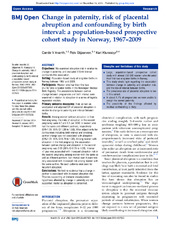| dc.contributor.author | Ananth, Cande V. | en_US |
| dc.contributor.author | Skjaerven, Rolv | en_US |
| dc.contributor.author | Klungsøyr, Kari | en_US |
| dc.date.accessioned | 2016-02-26T08:54:44Z | |
| dc.date.available | 2016-02-26T08:54:44Z | |
| dc.date.issued | 2015-02-10 | |
| dc.Published | BMJ Open 2015, 5(2):e007023 | eng |
| dc.identifier.issn | 2044-6055 | |
| dc.identifier.uri | https://hdl.handle.net/1956/11386 | |
| dc.description.abstract | Objectives: We examined abruption risk in relation to change in paternity, and evaluated if birth interval confounds this association. Setting: Population-based study of singleton births in Norway between 1967 and 2009. Participants: Women who had their first two (n=747 566) singleton births in the Norwegian Medical Birth Registry. The associations between partner change between pregnancies and birth interval were examined in relation to abruption in a series of logistic regression models. Primary outcome measures: Risk, as well as unadjusted and adjusted OR of placental abruption in relation to change in paternity and interval between births. Results: Among women without abruption in their first pregnancy, the risks of abruption in the second pregnancy were 4.7 and 6.5 per 1000 in women who had the same and different partners, respectively (OR=1.39, 95% CI 1.26 to 1.53). After adjustments for confounders including birth interval and smoking, partner change was not associated with abruption (OR=1.01, 95% CI 0.79 to 1.32). Among women with abruption in the first pregnancy, the association between partner change and abruption in the second pregnancy was 0.98 (95% CI 0.75 to 1.28). Interval <1 year was associated with increased abruption risk in the second pregnancy among women with the same as well as different partners, but interval over 4 years was only associated with increased risk among women with the same partner. No such patterns were seen for recurrent abruption. Conclusions: We find no evidence that a change in partner is associated with increased abruption risk. Theories supporting an immune maladaptation hypothesis afforded by change in paternity are not supported insofar as abruption is concerned. | en_US |
| dc.language.iso | eng | eng |
| dc.publisher | BMJ | eng |
| dc.relation.uri | http://bmjopen.bmj.com/content/5/2/e007023.full.pdf+html | |
| dc.rights | Attribution CC BY-NC | eng |
| dc.rights.uri | http://creativecommons.org/licenses/by-nc/4.0/ | eng |
| dc.title | Change in paternity, risk of placental abruption and confounding by birth interval: A population-based prospective cohort study in Norway, 1967-2009 | en_US |
| dc.type | Peer reviewed | |
| dc.type | Journal article | |
| dc.date.updated | 2015-11-19T09:42:59Z | |
| dc.description.version | publishedVersion | en_US |
| dc.rights.holder | Copyright 2015 The Authors | |
| dc.identifier.doi | https://doi.org/10.1136/bmjopen-2014-007023 | |
| dc.identifier.cristin | 1246272 | |
| dc.subject.nsi | VDP::Medisinske fag: 700::Helsefag: 800::Epidemiologi medisinsk og odontologisk statistikk: 803 | |
| dc.subject.nsi | VDP::Midical sciences: 700::Health sciences: 800::Epidemiology, medical and dental statistics: 803 | |
| dc.subject.nsi | VDP::Medisinske fag: 700::Klinisk medisinske fag: 750::Gynekologi og obstetrikk: 756 | |
| dc.subject.nsi | VDP::Midical sciences: 700::Clinical medical sciences: 750::Gynaecology and obstetrics: 756 | |

